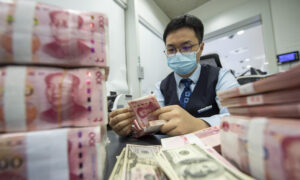The IMF’s Asia Forecast Misses a Lot
Commentary New projections on Asian growth from the International Monetary Fund (IMF) paint a bright picture—too bright, in fact. The organization relies on the positive effects of China’s reopening to forecast not only rapid real growth for China but also for other Asian economies, including India, Vietnam, Bangladesh, and Mongolia. Though there can be little doubt that China’s reopening will act as a spur to growth throughout the region, the upbeat IMF forecast seems to dismiss the ill effects of inflation and fails entirely to consider the drag on Chinese and Asian exports from tight monetary policies in the West. IMF projections are nothing short of remarkable. They include an expectation that China’s real growth will surge 5.2 percent in 2023, Vietnam’s will come in at 5.8 percent, India will grow 6.1 percent, and Cambodia will top the growth polls at 6.2 percent. This forecast sees lower growth in Asia’s fully developed economies, but still, in most cases, stronger than even the government projections, including 1.8 percent real growth for Japan in 2023 and 1.7 percent for South Korea. For Asia as a whole, the IMF tallies real growth to 4.7 percent, and for less-developed Asia, where the IMF groups China, it expects a total 5.3 percent. Throughout, the report ties its upbeat picture to a Chinese resurgence now that zero-COVID restrictions have lifted. Its authors point consistently to the surge in Chinese travel that occurred immediately on the economy’s reopening and the consumer spending surge that accompanied it, mostly on hotel bookings, other such services, and luxury goods. Noting that most Asian trade occurs among the economies in the region as well as the strong trade and tourism linkages between China and the rest of Asia, the authors see the China surge spreading. Few would dispute the recent evidence of a surge in Chinese consumer spending or the validity of the linkages to which the IMF report points, but these considerations fail to cover the full economic picture. They miss, for instance, the immediate economic drag from the surge in COVID-19 cases that has been accompanying China’s abandonment of its zero-COVID policies. Similarly, this bright picture overlooks questions about the sustainability of the initial spending surge, and how rather it is concentrated among China’s wealthy who amassed considerably more spending power in the lockdowns than the bulk of China’s population. The upbeat forecast also overlooks the problems plaguing China’s important property development sector and the continued steep decline in housing sales. Similarly, it fails to account for the drop in real estate prices, where most Chinese have the bulk of their wealth, and how it has imbued considerable spending caution among everyday people as opposed to the very wealthy. Surveillance cameras are seen near a real estate project under construction in Shenzhen, China, on Nov. 8, 2021. (David Kirton/Reuters) The IMF also seems to ignore what is happening in Japan and the West. Both the United States and Europe, as well as Canada, Australia, New Zealand, and Japan, have each pursued counter-inflationary monetary policies that have restricted credit flows and raised interest rates. These policies all seem bound to intensify in coming months. Recession in 2023 may not result from this restraint, but it is likely, and such policies at the least will slow growth. China’s still vital export sector will suffer accordingly. The World Bank, noting these trends, has reached very different conclusions from the IMF. It has reduced its real growth forecast for the global economy from 3.0 percent not too long ago to only 1.7 percent. On top of these economic adversities is the increasing hostility Washington shows toward China trade and, to a lesser extent, shown by the European Union (EU). In just the last few months, Washington has passed noteworthy pieces of legislation to curtail trade with China and investment in China. The trade restrictions, besides continuing tariffs, have focused mostly on technology, semiconductors in particular, but that is no small part of the picture. Investment restrictions that have just recently gone into effect will enlarge the ill effects of the trade restrictions. The EU has shown less overt hostility than Washington, but it, too, has exhibited a willingness to take counter-measures to what it clearly considers Beijing’s unfair trade practices. Meanwhile, American and European business, independent of their governments, have begun to rethink their former reliance on China trade. Their reasons have to do with supply-chain resiliency, disenchantment about China’s reliability as a place to source, rising costs, and long-standing objections to Beijing’s policies. Combined, these considerations have culminated in some dramatic reversals. In just the last few months, for example, Apple, Samsung, Volvo, and Adidas, among others, have announced that they will move production from China, somet

Commentary
New projections on Asian growth from the International Monetary Fund (IMF) paint a bright picture—too bright, in fact. The organization relies on the positive effects of China’s reopening to forecast not only rapid real growth for China but also for other Asian economies, including India, Vietnam, Bangladesh, and Mongolia. Though there can be little doubt that China’s reopening will act as a spur to growth throughout the region, the upbeat IMF forecast seems to dismiss the ill effects of inflation and fails entirely to consider the drag on Chinese and Asian exports from tight monetary policies in the West.
IMF projections are nothing short of remarkable. They include an expectation that China’s real growth will surge 5.2 percent in 2023, Vietnam’s will come in at 5.8 percent, India will grow 6.1 percent, and Cambodia will top the growth polls at 6.2 percent. This forecast sees lower growth in Asia’s fully developed economies, but still, in most cases, stronger than even the government projections, including 1.8 percent real growth for Japan in 2023 and 1.7 percent for South Korea. For Asia as a whole, the IMF tallies real growth to 4.7 percent, and for less-developed Asia, where the IMF groups China, it expects a total 5.3 percent.
Throughout, the report ties its upbeat picture to a Chinese resurgence now that zero-COVID restrictions have lifted. Its authors point consistently to the surge in Chinese travel that occurred immediately on the economy’s reopening and the consumer spending surge that accompanied it, mostly on hotel bookings, other such services, and luxury goods. Noting that most Asian trade occurs among the economies in the region as well as the strong trade and tourism linkages between China and the rest of Asia, the authors see the China surge spreading.
Few would dispute the recent evidence of a surge in Chinese consumer spending or the validity of the linkages to which the IMF report points, but these considerations fail to cover the full economic picture. They miss, for instance, the immediate economic drag from the surge in COVID-19 cases that has been accompanying China’s abandonment of its zero-COVID policies. Similarly, this bright picture overlooks questions about the sustainability of the initial spending surge, and how rather it is concentrated among China’s wealthy who amassed considerably more spending power in the lockdowns than the bulk of China’s population. The upbeat forecast also overlooks the problems plaguing China’s important property development sector and the continued steep decline in housing sales. Similarly, it fails to account for the drop in real estate prices, where most Chinese have the bulk of their wealth, and how it has imbued considerable spending caution among everyday people as opposed to the very wealthy.

The IMF also seems to ignore what is happening in Japan and the West. Both the United States and Europe, as well as Canada, Australia, New Zealand, and Japan, have each pursued counter-inflationary monetary policies that have restricted credit flows and raised interest rates. These policies all seem bound to intensify in coming months. Recession in 2023 may not result from this restraint, but it is likely, and such policies at the least will slow growth. China’s still vital export sector will suffer accordingly. The World Bank, noting these trends, has reached very different conclusions from the IMF. It has reduced its real growth forecast for the global economy from 3.0 percent not too long ago to only 1.7 percent.
On top of these economic adversities is the increasing hostility Washington shows toward China trade and, to a lesser extent, shown by the European Union (EU). In just the last few months, Washington has passed noteworthy pieces of legislation to curtail trade with China and investment in China. The trade restrictions, besides continuing tariffs, have focused mostly on technology, semiconductors in particular, but that is no small part of the picture. Investment restrictions that have just recently gone into effect will enlarge the ill effects of the trade restrictions. The EU has shown less overt hostility than Washington, but it, too, has exhibited a willingness to take counter-measures to what it clearly considers Beijing’s unfair trade practices.
Meanwhile, American and European business, independent of their governments, have begun to rethink their former reliance on China trade. Their reasons have to do with supply-chain resiliency, disenchantment about China’s reliability as a place to source, rising costs, and long-standing objections to Beijing’s policies. Combined, these considerations have culminated in some dramatic reversals. In just the last few months, for example, Apple, Samsung, Volvo, and Adidas, among others, have announced that they will move production from China, sometimes to places elsewhere in Asia and sometimes further afield.
As if to confirm the effects of these trends, Beijing’s customs bureau recently reported steep declines in China’s export volumes. Last December, the most recent period for which data are available, the bureau recorded a 9.9 percent drop in overall exports from levels of December 2021. With monetary restraint in the American, European, and Japanese economies, this trend is hardly likely to reverse anytime soon, though it will no doubt moderate. It is equally unlikely that China’s luxury spending trend can overcome these effects even if it lasts, which itself is open to question. Chances are good, then, that the IMF will publish a downward revision in its projections soon.
Views expressed in this article are the opinions of the author and do not necessarily reflect the views of The Epoch Times.












